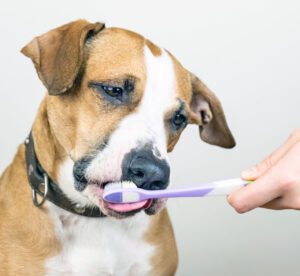Everyone should brush their dog’s teeth every day. It even helps with a dog’s bad breath! If you need more motivation than that, regular brushing can save huge (huge!) amounts of money later by avoiding expensive, painful dental surgeries and tooth extraction. Although daily brushing is statistically proven to make the most difference, as the Veterinary Oral Health Council (VOHC) advises, any brushing is better than no brushing. If weekly is all you can manage, that will still help your dog.
Keeping your dog’s teeth brushed regularly helps avoid tooth loss, heart disease, diabetes, and sinus problems that are caused at least partially by bad dental care. Dogs also get periodontal disease just like we do, from neglected teeth. Periodontal disease painfully destroys the bone and gums that hold the teeth in place. A dog with painful teeth won’t eat well, if at all.
Toothbrush Choices
It’s best to choose a brush made for dog, but many people successfully use a child’s toothbrush on a small dog and an adult toothbrush for a larger dog (soft bristles only). Pay attention to the size of the brush you choose. An oversized brush will be uncomfortable for a little dog, and a tiny brush will be inefficient for use on a larger dog. Always clean the brush and allow it to dry out thoroughly between brushings, just like you do your own. Note: The finger brushes really don’t work well.
The VOHC list of approved products includes some dental chews. While some people may scoff at the effectiveness of dental chews, a study published in the Journal of Veterinary Dentistry disagrees: “Adding a dental chew to the diet results in statistically significant reductions in plaque and calculus accumulation, and oral malador while improving gingival indices.” In other words, dental chews help.
Use Toothpaste for Dogs
Toothpaste made for dogs includes enzymes that help destroy bacteria in the dog’s mouth. Bacteria is what promotes plaque, and plaque hardens into sticky, destructive tartar. The enzymes in the toothpaste are powerful. A few dogs who absolutely refuse to allow a toothbrush in their mouth can be helped at least somewhat if you can just rub the toothpaste on their gums. Again, daily is preferable.
Usually the toothpaste is flavored, and most dogs like it. (Human toothpaste is made to be spit out, not swallowed; never use human toothpaste for your dog.) Try to choose products that are accepted by the VOHC because that means there is proof that the products work.
Technique
Start slowly, and be patient. Let the dog lick the enzymatic toothpaste off the brush—if that’s all you can do, that’s fine for a start. If you can get the brush in the dog’s mouth, just brush a few of the dog’s teeth. don’t fight him. Be gentle. Reward your dog frequently and richly with treats and praise. For a thorough lesson on technique, watch this video from the University of California, Davis, Veterinary School.
Finally, when you brush your dog’s teeth, pay special attention to the outer surface of the upper teeth, cheek side, which accumulates a great deal of tartar. “Dental plaque and tartar accumulate most rapidly on the buccal (cheek) surfaces of the upper teeth,” according to the VOHC.






